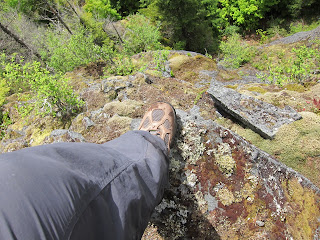June 18, 2012
This day was dedicated to the north central part of the
park, which we accessed by a long drive first toward the valley, then west, and
finally east on the Tioga Pass road.
After about 15 miles on that road, which was laid out by John? Olmsted, we stopped at a trailhead for a hike
to May Lake.
 |
| May Lake and Mt. Hoffman |
 |
| Rocky terrain near May Lake |
 |
| Overlooking May Lake |
 |
| Mt. Hoffman |
 |
| May Lake with the last patch of residual snow. |
The sign said 2.7 miles and
the map showed that it wasn’t particularly steep, both of which sounded perfect
after our arduous climb up Yosemite Falls on the 16th. As promised, the trail was relatively gentle,
climbing through a sparse pine forest that has taken hold in the thinnest,
least organic soil imaginable. The girth
of some of these trees approached six feet, which was impressive because of the
soil and the 9,000 altitude. Austin and
I wondered if it was actually the lean soil that discouraged competition
between trees that allowed the hearty ones to grow so well. The trail proper was either soft, dry deep sand that was a little hard to walk in or smooth granite.
 |
| Snow Survey cabin. |
About a mile into the hike we crossed paths with a couple
who asked us if we had a map. I told
them our map was safely in the car where it belonged, which is where theirs was
as well. They said they had walked 2 ½
miles and did not find the lake, instead they turned around at a surveyors
cabin. Taking this in mind, we kept our
eyes out for a cross trail that they might have missed. Seeing none, we kept walking until we reached
the cabin that was intended as refuge for snow survey crews. Since we had walked neither 2 1/2 miles or felt the least tired, we continued onward, rising gently through beautiful groves of trees. Shortly, we came across a construction crew that was clearing a parking area. This seemed more than a little odd and left us a bit discombobulated.
 |
| Granite and pines near May Lake |
Crossing the work area the landscape transitioned to vast open expanses of cracked and blocky, gray granite. The vistas opened up as well: a ridge lay before us, with a peak just behind, a perfect place for a mountain lake. Turning about, gently curved but incredibly massive rock surfaces stretched for miles in all directions. The bowels of the earth have inched their way to the surface, stretching and expanding, pushing higher until all but the heartiest life has been shed. From here, the lake is little more than 1/2 mile up the ridge on a couple of easy switchbacks. The lake is fairly small and nearly circular surrounded by signs warning not to swim because it is the water supply for Yosemite Park.
 |
| Me and Austin |
There were several groups camping near the lake and two canvas-sided cabins on the northwest side, called the May Lake High Sierra Camp, as we later learned. The lake sits at 9,270 feet and is lorded over by Mt. Hoffman, towering to 10,850 feet. We decided to continue up to the shoulder of the mountain to see if the views improved. The trail was a little steeper but still quite manageable. After about 1/2 mile the terrain flattens in an expansive high mountain meadow, rising to the west is Mt. Hoffman, and to the east a low ridge. We decided to leave Hoffman for another trip and ambled over to the ridge which offered and amazing view of the batholith and a fleeting view of the lake below.
After a short stay we returned to the car and continued our drive east, rising through Tuolome Meadows and on to Tioga Pass. The return trip to Wawona Campground was uneventful but long, it must have taken two hours to drive. It gave us a sense of the enormity of the park, especially when we realized that we had seen less than half of it.
 |
| Austin admiring his cairn creation. |







































 The trail follows another mostly wooded draw between two
massive granite walls. One switchback
after another, and another led us to the top.
We crossed paths with many hikers and a few campers along the way as
this is a very popular route. We grew
increasingly tired as we neared the end of our journey: the heat, the altitude,
and our lack of fitness, combined to take a toll on each of us. The trail
splits at the top, the way to the right leads to an overlook of the valley and
a bit farther to the creek. It was quite
a relief to pull off the boots and dip ones toes into the cool water.
The trail follows another mostly wooded draw between two
massive granite walls. One switchback
after another, and another led us to the top.
We crossed paths with many hikers and a few campers along the way as
this is a very popular route. We grew
increasingly tired as we neared the end of our journey: the heat, the altitude,
and our lack of fitness, combined to take a toll on each of us. The trail
splits at the top, the way to the right leads to an overlook of the valley and
a bit farther to the creek. It was quite
a relief to pull off the boots and dip ones toes into the cool water. 








